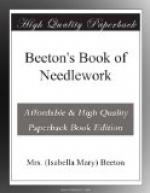[Illustration: 428.—Linen Braid.]
[Illustration: 429.—Linen Braid.]
[Illustration: 430.—Linen Braid.]
[Illustration: 431.—Linen Braid.]
The BRAIDS are of various widths and kinds. None but pure linen braid should be employed; those with machine-made edgings are eschewed by many lace-workers, the plain, loose-woven linen braid of various widths and qualities being alone acceptable to experienced hands.
But all ladies do not care to be at the trouble of edging the braid, and will find Nos. 426, 428, 430, and 431 very useful. No. 429 is a plain linen braid with a vandyked edge, which works out very prettily. No. 431 is an edged braid with open holes, in imitation of the point lace work of the fifteenth century.
Point lace cords resemble the satin stitch embroidery in their close, regular smoothness; the price is 1s. per hank, and they are of various thicknesses, from the size of a coarse crochet thread up to that of a thick piping cord. These cords are used to ornament the braid, and are closely sewn on the braid, following its every outline, and serve as beading to the edging, being always sewn on the outer edge alone. The finer kinds of this cord are used in place of braid where very light work is needed, as in the point lace alphabet which forms the frontispiece of this work. Directions for laying on the cord when employed as braid are given on page 500. When used as a finish only, and to impart the raised appearance of Venice and Spanish lace, it is fixed on the braid by plain, close sewing. The thread used should be Mecklenburg linen thread; that of Messrs. Walter Evans and Co. we strongly recommend as being of pure linen, washing and wearing well; it is pleasant to work with, from the regularity and evenness of the make. The numbers run thus:—2, 4, 6, 8, 10, 12, 14, 16, 18, 20, 24, 30, 36, and 40—and will be found adapted for every kind of lace stitch. No. 2 is the coarsest, No. 40 the finest, size.
In working point lace the following directions must be attended to: Begin at the left hand, and work from left to right, when not otherwise directed, as in reverse rows. Before cutting off the braid run a few stitches across it to prevent it widening. Joins should be avoided, but when a join is indispensable, stitch the braid together, open and turn back the ends, and stitch each portion down separately. When passing the thread from one part to another, run along the centre of the braid, allowing the stitches to show as little as possible. In commencing, make a few stitches, leaving the end of the thread on the wrong side and cutting it off afterwards. In fastening off, make a tight button-hole stitch, run on three stitches, bring the needle out at the back, and cut off.
Having now completed our list of materials, we can proceed to lay on the braid.
[Illustration: 442.—Mode of Placing the Braid.]




